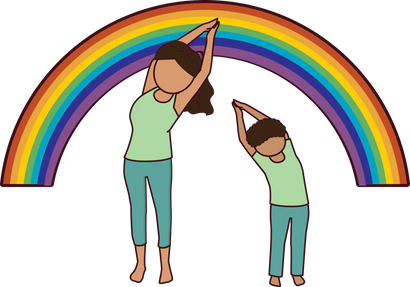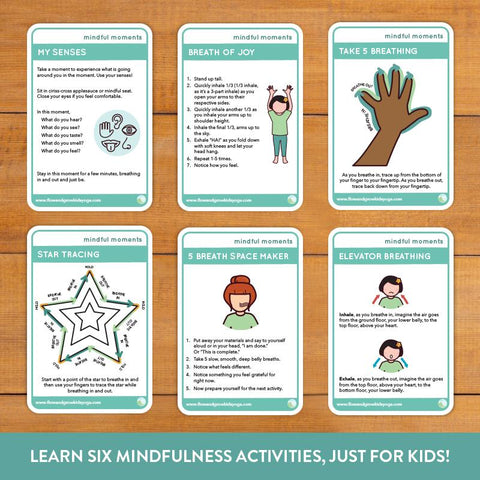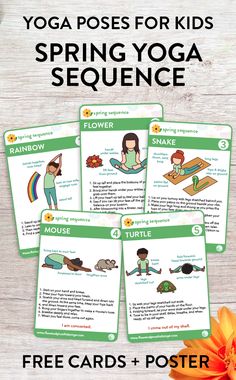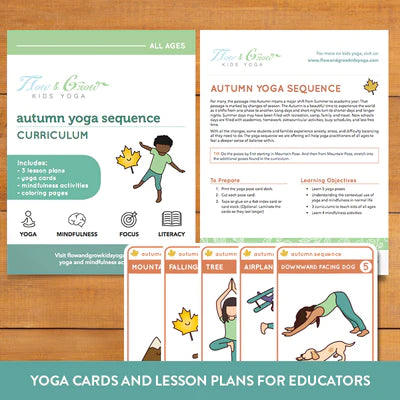Your Cart is Empty
22% off Automatically at checkout when you spend $5 of more!
22% off Automatically at checkout when you spend $5 of more!

3 Practical Values That Kids Learn Through Yoga
by Lara Hocheiser February 04, 2021 5 min read
By Oyegoke Motolani Oluwakemi, via Simple Smart Science (simplesmartscience.com)
Note from Flow and Grow Kids Yoga: Ever wonder why we're so passionate about what we do? This piece shares some important reasons why.

The practice of yoga generates self-awareness, discipline, and perseverance. Yoga, which hails from the Sanskrit wordsyuj -- which meansto join, is a practice that has been used for hundreds of years. As it came into the limelightdecades ago, many studies have been conducted on it. These studies have shown that yoga has a myriad of benefits -- including stress reduction, anxiety relief, decreases in inflammation, and a host ofother benefits.
However, most of the studies on yoga have been conducted on adults; it is rare to find a study on children. At the same time, direct experiences show us that yoga can help kids grow up healthier, happier, and reaching closer to their potentials. Here, we present three practical values thatchildren can reap from doing yoga.
- Yoga Can Alleviate Stress
Yoga for children can be a powerful weapon for alleviating stress, instilling calm, and improving in various other well-being metrics, especially when implemented in a school setting. As astudy from the National Institutes of Health illustrates, Norweigan children who practiced yoga used fewer drugs, performed better academically, and became more active participants during elections and more generally in society.
Another study reported that high school students who do yoga have better emotional balance and learn how to alleviate stress safely and effectively. The same study stated that children who practice yoga are better developed, exhibit better well-being, manage their weight more effectively, and mitigate emotional and behavioral problems.The study also demonstrated that stress-oriented programs for children are lacking, despite the fact that children in modern culture often experience a high level of stress.
Want to learn some simple yoga tools for helping kids and youth manage stress and other difficult emotions? We offer a course on that!
The same study reported that these effects of yoga for children are significant -- not just minor changes -- particularly for reducing the feelings of aggression and helplessness. In addition, students brought the techniques that they learned during yoga outside of the classroom. The aim of these techniques were to bring feelings of calm, improve well-being, and to reduce the impact of negative emotions.
TheMayo Clinic recommends yoga for relaxation and stress alleviation. According to that renowned medical institution, yoga’s health benefits are stress reduction, improved fitness, and chronic conditions management. These benefits can be extended to children as well.
- Increased Self-Awareness
The goal of yoga is to develop self-awareness, and this also holds true for children as they develop their understanding of their own emotions.Through yoga, children can recognize and categorize how they feel and become more empathetic towards others and the emotions they experience. MIT conducteda study on the efficacy of mindfulness for children in two Boston schools, and the results are encouraging; students who underwent mindfulness training reported reduced stress levels and fewer negative feelings.
Mindfulness, which includes being aware of one’s own emotions, is at the core of yoga. Such awareness can have a powerful impact on children. It helps them to identify how they feel, and additionally allows them to determine what will alleviate negative emotions and increase positive ones. This emotional awareness, which starts on the yoga mat, shifts their mindset from “I” to “we.” That shift increases children’s emotional maturity.
Due to a relative lack of research, yoga’s ability to help children handle psychosocial stress is still unclear -- from an empirical perspective, that is.The current theory suggests that yoga practice changes the extent to which people experience particular events as stressful. Thus, how children feelabout their feelings enhances self-awareness and reduces stress.
On a physical level,Asana(poses) cultivates awareness in people practicing yoga. For instance, those who practice yoga become acutely aware of their own body. They know which muscles are being stretched and how far they are being stretched.
Yoga is much more than poses, but we have a course for how to teach postures in an anatomically and developmentally informed way -- check it out!

- Discipline
This is perhaps the number one value that children learn when they practice yoga. This is not said to promote punishment, limiting a child’s unique self-expression, or disregarding their needs in the goal of making them behave a certain way. More and more, the fields of teaching, parenting, and child psychology are demonstrating that those are not effective approaches (apart from being unpleasant for all involved). The “discipline” at hand here is discipline in the yoga sense of the word, known astapas-- consistent work towards self-improvement and other ways of creating positive change.
In that yogic perspective, mindfulness encourages discipline.Studies have shown that mindfulness in children is associated with better behavioral and emotional outcomes. Yoga is best practiced consistently and under certain conditions (with a certain amount of flexibility according to different practitioners’ lives, unique wants and needs, et cetera). This consistency can encourage that art and skill of discipline, in thetapassense, in children. Paired withmeditation, this predictability can lead children to feel calmer, more peaceful, and happier following sessions of yoga.
Through yoga,discipline teaches children self-control and to make the proper choices. This kind of discipline encourages children to practice self-inquiry, transformation, and growth. In addition, children learn the art of self-reflection through discipline.

Another important aspect of that discipline is developing concentration and focus, which allows one to successfully concentrate on the task at hand. From there, children get better grades in school and reportimproved concentration. Yoga and the self-discipline it can create those effects. On top of that, yoga and meditation can help children develop better self-esteem and confidence. That effect comes from yoga fostering in children an enhanced sense of self.
On an even more practical and logistical level, the consistency of yoga can guide children to learn how to schedule their day, manage their time, and manage the emotions that scheduling and time-management can bring. Besides the fact that yoga teaches them meditation and self-awareness, the discipline that comes from yoga’s routine, and the concentration that is entailed when they need to hold a pose or breath a certain way for a period of time, children become better at identifying their stressors. They also become better at studying, which circles back to yoga’s ability to bring improved academic performance.
Conclusion
Yoga is both art and exercise. Although it has been practiced for hundreds of years, it has only entered public consciousness in recent decades. Those who practice yoga report better self-esteem, an increased sense of calm, and better focus and concentration. These same benefits extend to children who practice yoga. They learn three core values, among others: stress alleviation, self-awareness, and discipline.
Through these values, they become better at managing themselves and their emotions. They perform better academically and are usually calmer and more focused. Yoga should be part of every household’s activity as well as part of every school’s offerings. It is the best way to encourage children to grow and develop healthy and strong, both mentally and physically.
About the Author:
Oyegoke Motolani Oluwakemi is a freelance writer, poetess and author of insightful articles for Nettra Media. She writes on different niches, especially exciting ones that opens her up to new challenges.
Leave a comment
Comments will be approved before showing up.
Also in Kids Yoga Blog

How Social and Emotional Learning and Yoga Help Kids Breathe Through Big Emotions
by Kane SEO April 21, 2025 4 min read
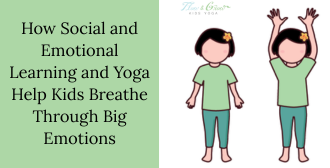
How Social and Emotional Learning and Yoga Help Kids Breathe Through Big Emotions
by Kane SEO April 14, 2025 4 min read
In classrooms and communities around the world, educators and parents alike are placing a growing emphasis onsocial and emotional learning. And for good reason: helping children understand, manage, and express their emotions in healthy ways is just as critical as teaching them to read or do math.

Power of Yoga for Kids: How It Helps Them Grow, Focus, and Thrive
by Kane SEO March 25, 2025 5 min read
In today’s fast-paced world, children are often exposed to stressors from a young age, whether it’s academic pressure, social challenges, or the overwhelming influence of digital devices. This can impact their physical, mental, and emotional well-being.
Ultimate Kids Year of Yoga Bundle
bundlespricey-contentdigital-resourcesearly-childhood-yoga-mindfulnesselementary-yoga-mindfulnesskids-yoga-resourcesmiddle-high-school-yoga-mindfulnessseasonal-yogayoga-cards
Ultimate Kids Year of Yoga Bundle
5 reviews
5.0 / 5.0
(5) 5 total reviews
$45.00
Ultimate Kids Year of Yoga Bundle
5 reviews
5.0 / 5.0
(5) 5 total reviews
$45.00
Kid’s Sun Salutation Yoga Cards
digital-resourcesearly-childhood-yoga-mindfulnesselementary-yoga-mindfulnesskids-yoga-resourcesliteracyunder-15yoga-cards
Kid’s Sun Salutation Yoga Cards
3 reviews
4.33 / 5.0
(3) 3 total reviews
$10.00
Kid’s Sun Salutation Yoga Cards
3 reviews
4.33 / 5.0
(3) 3 total reviews
$10.00
Yamas and Niyamas: Successful Relationships with Self & Others (tweens and teens)
pricey-contentdigital-resourceskids-yoga-resourceslesson-plansmiddle-high-school-yoga-mindfulnessmindfulness
Yamas and Niyamas: Successful Relationships with Self & Others (tweens and teens)
2 reviews
5.0 / 5.0
(2) 2 total reviews
$49.00$55.00
Yamas and Niyamas: Successful Relationships with Self & Others (tweens and teens)
2 reviews
5.0 / 5.0
(2) 2 total reviews
$49.00$55.00
